#commercial cost estimation
Text
#top construction management firms in florida#commercial construction management company florida#project management residential construction#project management for construction industry deerfield beach#best construction cost estimators in florida
0 notes
Text
#Construction Estimating#Construction Estimating Resources#Reliable Construction Cost Analysis#Professional Construction Estimator#Construction Estimating Techniques#Industrial Construction Estimates#Best Practices for Construction Estimating#Commercial Construction Cost Estimates#Construction Estimating Services#Accurate Construction Estimates#Cost Estimation for Construction Projects#Construction Cost Estimating Software#Construction Estimating Software#Construction Estimating Tools#Residential Construction Estimates#Construction Estimating Process#Construction Quantity Takeoff#Construction Budgeting and Estimating#Constructin Estimating Consultants#Construction Estimating Accuracy#Construction Estimates Templates#Construction Estimating Training#Construction Takeoff Software#Construction Estimate Comparison#Construction Bid Estimation#Construction Estimating Tips#e-procurement#Building Materials & Supplies#3D Renderings#Construction Spreadsheets
1 note
·
View note
Text
Why is Document Management Software Important in Construction Industry?

Managing digital documents is a complex task, especially in the building industry. The problem is that most records are unstructured. It's hard to find the necessary information and challenging to complete a workflow. Document management software saves you time and ensures your files are secure.
Along with DMS, your construction company should choose the right Commercial estimating software. These online systems reduce mistakes and improve the accuracy of your bids and documentation.
You can coordinate with suppliers and subcontractors more practically through efficient and user-friendly DM and estimating software. This will allow you to make better estimates and create secure records for each project.
Automation of File Keeping and Retrieval
Automating the process of document creation, storage, distribution, and review can increase productivity in your business. Document automation tools help employees to fill out and submit documents faster. It can also reduce errors and redundancies.
The benefits of automation include more accurate and consistent documentation, reduced risk of business-damaging fines, and improved client satisfaction.
Enhanced Collaborations
Document Management systems help team members work together. By storing all your documents in a centralized location, you can easily find them and share them with colleagues. Electronic records are perfect for inter-office distribution and working with clients.
Reliable software will have substantial version control, allowing users to check and reject changes with just one click. You should also be able to restrict access to authorized roles. A document management system should also enable your organization to comply with regulatory compliance requirements.
Saves Companies from Costly Litigation
A well-implemented solution can streamline your workflows and minimize the time spent on administrative tasks. Creating a central repository for all important documents will save you the time and hassle of relocating paper files. You can also access files from anywhere and work with colleagues across offices.
Implementing a digital record management system will also eliminate the need for multiple copies of the same document.
Bizprac helps users maximize their profit. An industry-leading Australian support team with extensive industry knowledge will also support you. Visit their website to learn more. https://www.bizprac.com/
#Document management software#Commercial estimating software.#construction software#construction project management software#construction management software australia#construction job management software#construction accounting software#building industry software#construction estimating software#best construction estimating software#building estimation and costing software#home building estimating software
0 notes
Text
"Marginal improvements to agricultural soils around the world would store enough carbon to keep the world within 1.5C of global heating, new research suggests.
Farming techniques that improve long-term fertility and yields can also help to store more carbon in soils but are often ignored in favor of intensive techniques using large amounts of artificial fertilizer, much of it wasted, that can increase greenhouse gas emissions.
Using better farming techniques to store 1 percent more carbon in about half of the world’s agricultural soils would be enough to absorb about 31 gigatons of carbon dioxide a year, according to new data. That amount is not far off the 32 gigaton gap between current planned emissions reduction globally per year and the amount of carbon that must be cut by 2030 to stay within 1.5C.
The estimates were carried out by Jacqueline McGlade, the former chief scientist at the UN environment program and former executive director of the European Environment Agency. She found that storing more carbon in the top 30 centimeters of agricultural soils would be feasible in many regions where soils are currently degraded.
McGlade now leads a commercial organization that sells soil data to farmers. Downforce Technologies uses publicly available global data, satellite images, and lidar to assess in detail how much carbon is stored in soils, which can now be done down to the level of individual fields.
“Outside the farming sector, people do not understand how important soils are to the climate,” said McGlade. “Changing farming could make soils carbon negative, making them absorb carbon, and reducing the cost of farming.”
She said farmers could face a short-term cost while they changed their methods, away from the overuse of artificial fertilizer, but after a transition period of two to three years their yields would improve and their soils would be much healthier...
Arable farmers could sequester more carbon within their soils by changing their crop rotation, planting cover crops such as clover, or using direct drilling, which allows crops to be planted without the need for ploughing. Livestock farmers could improve their soils by growing more native grasses.
Hedgerows also help to sequester carbon in the soil, because they have large underground networks of mycorrhizal fungi and microbes that can extend meters into the field. Farmers have spent decades removing hedgerows to make intensive farming easier, but restoring them, and maintaining existing hedgerows, would improve biodiversity, reduce the erosion of topsoil, and help to stop harmful agricultural runoff, which is a key polluter of rivers."
-via The Grist, July 8, 2023
#agriculture#sustainable agriculture#sustainability#carbon emissions#carbon sequestration#livestock#farming#regenerative farming#native plants#ecosystems#global warming#climate change#good news#hope
4K notes
·
View notes
Text
The Importance of Document Management in Construction Projects

Document management is vital to the success of construction projects. It helps stakeholders find the information they need and avoids disputes. If a project document is missing, it could mean the difference between successful project completion and legal action. In addition, document management keeps all project documentation safe.
Secure Digital Document Storage System
One of the biggest challenges in running a construction business is storing and sharing project documents. That's why you'll need secure document management software. These cloud-based solutions can help you maintain a central library of project documents and protect your company's data from theft or loss. They also allow you to share documents with anyone who needs to see them, including other members of your extended team.
Having an easy-to-use, secure document control system can be the difference between success and failure. A good document management system (DMS) is a necessity when it comes to construction projects which require accurate calculations and pricing. By enabling remote sharing and storage, a DMS can save your project time and money. It can also make decision-making faster for project managers at multiple sites.
Open Communication with the Whole Team
Construction projects are complicated and often don't go as planned. That means that proper communication is essential to keep all parties informed of changes to documents, purchase orders, and requests for information.
Effective communication in construction can make the difference between a smooth project and a complicated one. By keeping open lines of communication, you can improve the management of construction documents and improve the collaboration between all members of the team.
Document Retention Policies
Document retention policies are important in the construction industry. Whether the project is digital or traditional, a builder company should have clear rules for preserving project documents. Most documents should be kept for at least 15 years after the project is complete. It is also important to have separate backups in case of system failure or document destruction.
Document retention policies should be specific to each company. They should consider the type of documents, the significance of the documents, the ongoing business functions, and the relationships the company has with third parties. These can include other businesses, employees, customers, partners, and government agencies.
Builder companies in Australia can use an integrated construction management software, Bizprac, for their various project administration needs. It also functions as a job control, costing, accounting, document management, and building material estimating software, all in one package.
Contact Biprac today to learn more about the product. https://www.bizprac.com/
#construction software#construction project management software#construction management software australia#construction job management software#construction accounting software#construction estimating software#building industry software#best construction estimating software#building estimation and costing software#home building estimating software#commercial construction project management software#building estimating software#asset building system#building estimating software australia#construction financial software#construction estimating software australia#commercial construction estimating software#commercial estimating software
0 notes
Text

The cost of damage to critical infrastructure in Gaza is estimated at around $18.5 billion according to a new report released today by the World Bank and the United Nations, with financial support of the European Union. That is equivalent to 97% of the combined GDP of the West Bank and Gaza in 2022.
The report finds that damage to structures affects every sector of the economy. Housing accounts for 72% of the costs. Public service infrastructure such as water, health and education account for 19%, and damages to commercial and industrial buildings account for 9%. For several sectors, the rate of damage appears to be leveling off as few assets remain intact. An estimated 26 million tons of debris and rubble have been left in the wake of the destruction, an amount that is estimated to take years to remove.
The report also looks at the impact on the people of Gaza. More than half the population of Gaza is on the brink of famine and the entire population is experiencing acute food insecurity and malnutrition. Over a million people are without homes and 75% of the population is displaced. Catastrophic cumulative impacts on physical and mental health have hit women, children, the elderly, and persons with disabilities the hardest, with the youngest children anticipated to be facing life-long consequences to their development.
With 84% of health facilities damaged or destroyed, and a lack of electricity and water to operate remaining facilities, the population has minimal access to health care, medicine, or life-saving treatments. The water and sanitation system has nearly collapsed, delivering less than 5% of its previous output, with people dependent on limited water rations for survival. The education system has collapsed, with 100% of children out of school.
The report also points to the impact on power networks as well as solar generated systems and the almost total power blackout since the first week of the conflict. With 92% of primary roads destroyed or damaged and the communications infrastructure seriously impaired, the delivery of basic humanitarian aid to people has become very difficult.
#yemen#jerusalem#tel aviv#current events#palestine#free palestine#gaza#free gaza#news on gaza#palestine news#news update#war news#war on gaza#gaza genocide#genocide#famine#al shifa hospital#unrwa#children of gaza
556 notes
·
View notes
Text
Space Station Concepts: Space Operations Center
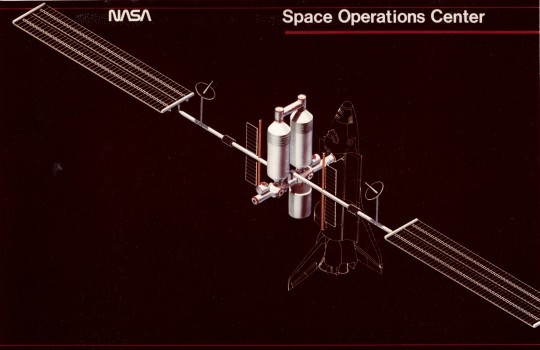

"The SOC is a self-contained orbital facility built up of several Shuttle-launched modules. With resupply, on-orbit refurbish- ment and orbit maintenance, it is capable of continuous operation for an indefinite period. In the nominal operational mode, the SOC is manned continuously, but unmanned operation is possible.

The present mission management and control process is characterized by a people-intensive ground monitoring and control operation involving large supporting ground information and control facilities and a highly- integrated ground-flight crew operation. In order to reduce dependence on Earth monitoring and control, the SOC would have to provide for increased systems monitoring; fault isolation and failure analysis, and the ability to store and call up extensive sets of data to support the onboard control of the vehicle; and the onboard capability for daily mission and other activity planning."
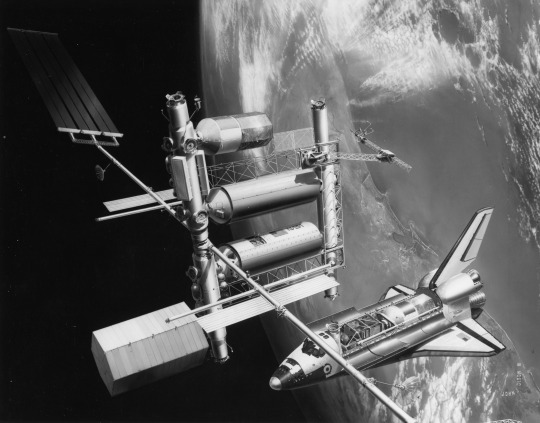

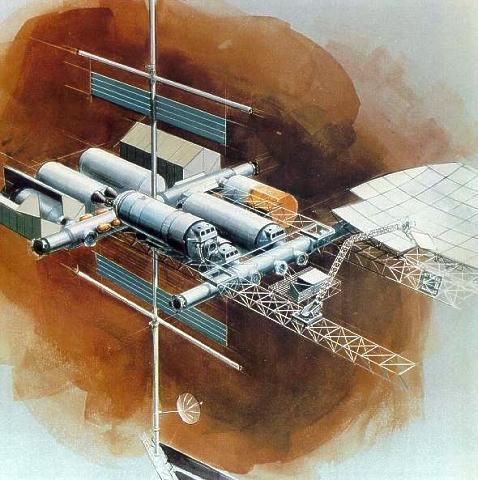
"Like most other space station studies from the mid/late 1970s its primary mission was the assembly and servicing of large spacecraft in Earth orbit -- not science. NASA/JSC signed a contract with Boeing in 1980 to further develop the design. Like most NASA space station plans, SOC would be assembled in orbit from modules launched on the Space Shuttle. The crew's tour of duty would have been 90 days. NASA originally estimated the total cost to be $2.7 billion, but the estimated cost had increased to $4.7 billion by 1981. SOC would have been operational by 1990.
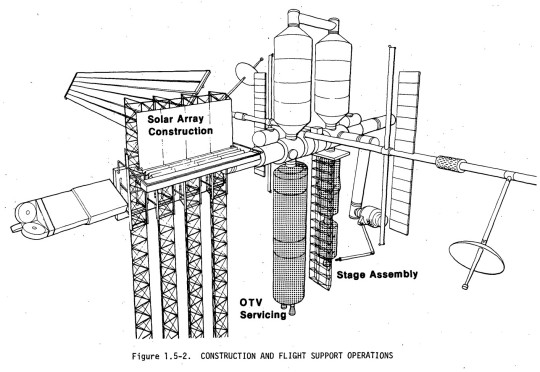
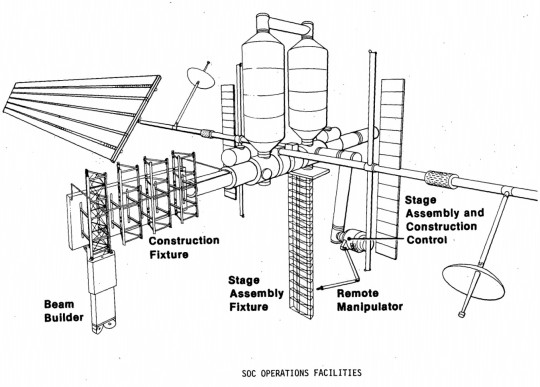

NASA's Johnson Spaceflight Center extended the Boeing contract in February 1982 to study a cheaper, modular, evolutionary approach to assembling the Space Operations Center. An initial power module would consist of solar arrays and radiators. The next launches would have delivered a space tug 'garage', two pressurized crew modules and a logistics module. The completed Space Operations Center also would have contained a satellite servicing and assembly facility and several laboratory modules. Even with this revised approach, however, the cost of the SOC program had grown to $9 billion. Another problem was Space Operations Center's primary mission: spacecraft assembly and servicing. The likely users (commercial satellite operators and telecommunications companies) were not really interested in the kind of large geostationary space platforms proposed by NASA. By 1983, the only enthusiastic users for NASA's space station plans were scientists working in the fields of microgravity research and life sciences. Their needs would dictate future space station design although NASA's 1984 station plans did incorporate a SOC-type spacecraft servicing facility as well."
Article by Marcus Lindroos, from astronautix.com: link

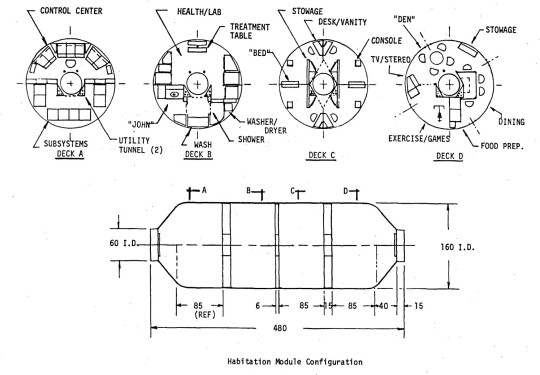


NASA ID: link, S79-10137
Boeing photo no. R-1859, link, link
#Space Operations Center#Space Station Freedom#Space Station Concept#Space Station#Concept Art#Space Station Program#Space#Earth#Space Shuttle#Orbiter#NASA#Space Shuttle Program#1979#1980s#my post
440 notes
·
View notes
Text
At the end of January, clips from a film about the housing market in Russian-occupied Mariupol began circulating on TikTok and X (formerly Twitter). After the start of Russia’s full-scale invasion of Ukraine, the Russian army held Mariupol under siege for 85 days, all the while relentlessly pummeling the city with missile and air strikes. Mariupol was effectively reduced to rubble, and no one knows how many lives were lost — though some estimates place the number as high as 100,000. As soon as the Russian authorities had captured the city, they set about rebuilding it and erasing any trace of war crimes.
The film, titled “Shocking Prices for Apartments in Mariupol — Millions for Ruins” was released in November on the YouTube channel “Mirnyie” (the plural form of “peaceful” in Russian and the first part of “peaceful inhabitants,” a Russian term used to distinguish non-combatants from military personnel in conflict zones). The Mirnyie project is led by “war correspondent” Regina Orekhova, a journalist from the Russian state news agency RIA Novosti. In 2022, she received a special award from the Russian Union of Journalists for “courage in fulfilling journalistic duty.”
The Mirnyie project, as one might surmise from its name, explores the lives of ordinary people in the conflict zone. “These are the stories of people who found themselves caught in the crossfire — some left, while others stayed. [We share] their experiences, how they survive, and what they think about,” reads the description. Judging by the channel, Orekhova primarily works in Mariupol. Previous reports of hers cover topics such as Azovstal’s underground tunnels, the sea port, city maternity hospitals, and the drama theater, which was destroyed by a Russian airstrike while an estimated 1,000 civilians were sheltering there.
In the introduction to the half-hour film, Orekhova promises to answer the following questions: “How do you buy an apartment in Mariupol? Is it more profitable to invest in ‘ruins’ that you can resell once renovated? How do you rent commercial space for a business here and how much does it cost? What kinds of apartments are for sale and what determines the price?” Orekhova explains that in Mariupol, there are “damaged buildings” as well as “brand new and renovated ones.” “The real estate market is very unconventional. We’ve studied it in detail and we’ll tell you all about it,” she promises.
Orekhova speaks with three local realtors who show her properties for sale in different parts of the city. As it turns out, these are mostly half-destroyed apartments, hastily abandoned by residents who left all their personal belongings behind as they fled. However, even such properties, according to the realtors, are in high demand. In some cases, actual ruins, where just parts of the walls survived the bombings, are for sale. However, Russian construction companies will restore these buildings later for free, which significantly increases prices. There’s also the rare property untouched by war, or newly renovated apartments in restored buildings. Prices for these range from four to six million rubles (about $50,000-$66,000). Apartments in historic Stalin-era buildings in the center of Mariupol with surviving inner courtyards (i.e., enclosed parking), renovated entrances, and sea views are considered premium housing.
The film doesn’t explain why or, more importantly, by whom all the housing in Mariupol was destroyed. Realtors talk evasively about “all those events” or “military actions.” Orekhova asks how many real estate agencies are currently operating in Mariupol. “Well, there aren’t many surviving citizens per square meter, you could say, but they exist, of course,” a realtor answers.
Showing a damaged three-room apartment in the center of Mariupol, real estate agent Natalia remarks that “one shouldn’t focus on the consequences of what happened to the apartment but on the apartment’s potential.” There’s no electricity, the ceiling is leaking, and personal belongings, including toys and a highchair, lie strewn about — but the windows have been replaced. Natalia points out the “magnificent view” from the balcony. “These buildings have survived more than one war and, as you can see, are still standing,” Natalia says encouragingly. According to her, it would be too painful for the previous owners to come back and see their home like this, which is why they’re looking to sell the apartment in its current condition.
The realtors say that apartments are mostly bought by newcomers “from big Russia” and bemoan that locals can’t afford newly constructed housing. According to them, Russian authorities introduced a special two percent mortgage rate for people from the self-proclaimed “Donetsk People’s Republic” and “Luhansk People’s Republic” who have Russian citizenship. But locals can’t get approved because most aren’t officially employed — there are no jobs with decent salaries in Mariupol.
Luisa, the head of a real estate management company, explains that it’s virtually impossible for Mariupol residents to get an apartment without Russia’s help. She says they “can’t afford to buy back their old homes in Mariupol or to purchase new ones.” When new construction is put up where their destroyed homes used to be, the mortgage payments are out of reach. Luisa recalls how an apartment building in the center, leveled in the bombings, was cleared away to make room for new construction. Residents were offered housing somewhere on the outskirts as compensation, but they weren’t able to buy apartments in the new building being built on their property, even though they’re legally registered at the address.
Tatiana, another realtor, thinks everything in Mariupol is “getting back on track.” She says people are returning, “even those who didn’t plan to.” “The demand [for apartments] is very high, much higher than the supply,” Tatiana explains. “If an apartment is in poor condition but at a good price, it goes quickly. The interested buyers are mainly newcomers. People from Siberia are also eyeing our seaside breeze.”
Tatiana tells Orekhova that everything is “looking up” for the city:
Mariupol has never experienced such rapid growth. The city is developing before our eyes. It’s happening in such a way that even we don’t know where things will improve tomorrow, where slums will turn into upscale neighborhoods. Because our sky is blue. When I say this, everyone smiles, actually. But before, our sky used to be gray or brown, never blue. And now life is getting better; every cloud has a silver lining. You just don’t want to remember the military operations; you go numb. But when you see what’s happening in Mariupol — everything will be fine, everything will work out.
130 notes
·
View notes
Text


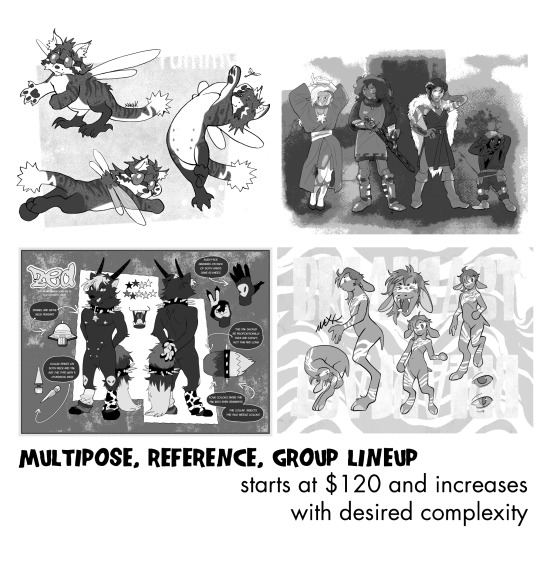

2dmax commissions info spring 2024
last updated april 12th
to place an order for a commission, you may PM me; if you prefer, you can also fill out this form or commission me through fiverr.
text and additional info below the readmore.
thanks for reblogging, even if you aren't interest right now!


Packages
These are excellent starting off points for most common commission types. Additional specificity and complexity can be purchased. All basic packages are artist's medium of choice, include simple backgrounds, minimal/no props. All include full color, fully finished works.
Standard Illustration - $80
Artistic and expressive "full body" illustration (roughly 75-100% of figure).
Mini Illustration - $50
Chibi, portrait, half body, icons, and the like.
Couple's Illustration - $100
A duo version of the above styles. Doesn't have to be romantic couples - friends, enemies, family, pet & owner, or other pairs and duos OK.
Multipose, Reference, and Group Lineups - $120+
For commissions that require either multiple poses of the same character, groups, more than two characters generally. Reference pages can include close-ups and detailed shots.
Experimental Commissions
18"x24" Handmade Poster - $200
artist’s choice of medium only. typically acrylic/mixed media. always on extra large poster sized paper. great way to celebrate your favorite OCs or canon characters!
paper clay figurine - $100
chibi humanoids/animals/ferals/anthros only. between 2"-3" cubed, give or take. armature wire, paper clay, paint, and varnish. these are delicate art items, not toys; not suitable for children. includes a photoset at no additional cost.
standalone comics page - $200
2-5 panels, 1-2 characters, 1 location. artist’s choice of medium only. can be OCs or canon characters.
wildcard commission - $???
submit your request and your budget; results are up to the artist.
pay what you want means get what you get!
here’s what to expect when you order:
Send me a PM with basic info; what you would like me to draw, your budget, and if you have a deadline.
I will ask a few questions to be able to build up the concept. I will also give you my e-mail, where you can send me further info and any references you’d like to share!
Your sketch is typically ready within a week; I’ll always update you on my progress. After we agree on the sketch, payment will be due. After it’s paid, I will give you an estimate for when I will be finished with your piece.
Your finished artwork will be e-mailed to you. I am also happy to mail physical art at cost!
terms and conditions:
Your commission is for personal use; icons, roleplaying, in your blog theme, as a wallpaper, or to print out and tape to your fridge. Commercial use can be negotiated.
You must credit me on the platform used if reposted. Always OK to post to ToyHouse; my username is 2dmax there. On instagram and all other platforms where I don’t have an account, please credit my instagram @/maximumgroove.
You may not use my art to promote anything hateful or illegal. You may not claim it as anyone else’s creation. You may not use it for commercial uses, or to edit, adapt, trace, or directly reference, without getting permission. I may use my art in my own promotional material.
➽ navigation
desktop view ★ F.A.Q.
browse my finished art ★ sketches ★ other media
look at buyables & adoptables
fan art ★ ttrpg art ★ flight rising art
ask me a question ★ browse my archive
visit my toyhou.se ★ follow me on instagram
#spring2024#art commissions#artists on tumblr#manga art#manga style art#anime art#nostaligiacore#webcore#furry art#traditional art#digital art#artist alley
75 notes
·
View notes
Text
The once-ubiquitous reality of working in an office for eight hours a day, five days a week is dead.
That means empty office buildings in cities such as San Francisco and Washington, DC have a better shot at eventually becoming repurposed because of how much trouble they’re in, including declining real estate values. Much also depends on the viability of repurposing a failed office building, Toohig said, which usually involves a study being done to determine whether the costs of repurposing a commercial building would be worth it in the long-run. To convert a commercial building into housing units, for example, a study would have to consider if there’s enough demand for housing in the area (other studies would consider different variables.)
CBRE, a commercial real estate services firm, said in estimates released Thursday that US office vacancy will likely increase further next year, reaching a 19.8% vacancy rate, up from 12.1% at the end of 2019.
Getting employees back into offices hasn’t been easy for some employers. In some cases, employees are protesting return-to-office mandates, such as at X, the website formerly known as Twitter.
85 notes
·
View notes
Text

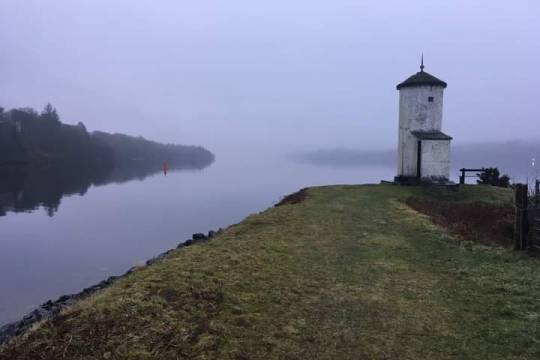



October 23rd 1822 saw the official opening of the Caledonian Canal.
Another one with conflicting dates, some say 30th of the month.
The Caledonian Canal bisects Scotland, linking the Irish Sea to the North Sea via the Great Glen. Its design and construction was state-of-the-art for the time, and advanced 19th century engineering methods considerably.
It was the famous Scot James Watt who first prepared a survey for a canal in the Great Glen in 1773 but nothing came of the project, in 1801 Thomas Telford produced a feasibility study and two years later an act of parliament in 1803 signalled the start of the project, although it was another year before work began. Telford worked with William Jessop on the survey, and the two men oversaw the construction until Jessop died in 1814. Jessop estimated the cost of the canal at £474,500 (excluding land purchases) and the construction time at seven years. In the event 18 years and cost £1.2m.
The Canal is 97km long. However, 60km of it is routed through four natural lochs — Dochfour, Ness, Oich and Lochy — leaving 37km of constructed channel. This involved the building of 28 locks, later increased to 29. These are all of a similar size and were then the world’s largest locks, at mainly 55m long, 12.2m wide and some 6m deep.
Though the canal was open for through traffic from 1822, there was still work to be done to complete the project to Telford’s plans. As part of the ongoing work, a third Act of Parliament received royal assent on 31st March 1825.
It wasn't long before the ships being built were too large for the canal, but it then began life as a tourist attraction, as it still does to this day.
Today, the Caledonian Canal is essentially as-created by Telford and Jessop. Its authentic conservation is encouraging increasing leisure use, and it is still a good shortcut for smaller commercial vessels.
74 notes
·
View notes
Text
(...)
"What is the Houthi movement?
The Houthi insurgency is a Zaydi Shiite Islamist political movement established in 1992 to challenge Yemen’s longtime, and increasingly corrupt, leader Ali Abdullah Saleh. Following massive street protests, Saleh resigned his post in 2011. After the resignation, a national unity dialogue was held in Yemen’s capital Sana’a to try to resolve a host of Yemeni political conflicts. However, those talks eventually broke down, prompting the Houthis to advance on Sana’a with the goal of taking power. This sparked Saudi Arabia’s deadly US-backed air, ground, and naval invasion of Yemen, which lasted for seven years and killed an estimated 9,000 civilians, as well as significant numbers of Houthi forces, in repeated airstrikes. Despite the overwhelming force used by Saudi Arabia, however, the Houthis gained control over roughly a third of Yemen’s land—and two-thirds of its population—over the course of the war.
In April 2022, Saudi Arabia and the Houthis negotiated a truce that has nearly eliminated the fighting in Yemen. The truce halted offensive military operations, allowed fuel ships to enter Yemeni ports, and restarted commercial flights from Sana’a airport. However, it did not offer a comprehensive political settlement, leaving open the threat of renewed hostilities.
How have the Houthis become involved in the war?
After Israel began bombing Gaza on October 7th, the Houthi movement—which has long held what Yemen expert Helen Lackner called a “fundamentalist foreign policy position against the US and Israel”—announced that it was ready to intervene in solidarity with Palestinians. “There are red lines in the situation related to Gaza, and we are coordinating with our brothers in the jihad axis and are ready to intervene with all we can,” the Houthis’ leader said. As part of this effort, the movement has carried out 27 attacks in the Red Sea between November 19th and January 11th, most of them on commercial ships linked to Israel (although some of the attacks have targeted ships without a clear connection to Israel). The movement has also tried to fire on American warships and on Israel itself.
In the attacks on commercial ships, the Houthis have mostly fired missiles at them, though on November 20th, the group’s fighters seized a cargo ship and detained the crew members onboard. These attacks have discouraged shipping companies from traversing the Red Sea, the fastest route from Asia to Europe; many are instead sailing around the Horn of Africa, which adds $1 million to the typical cost of a roundtrip. On January 11th, the White House cited this trade disruption as a key motivating factor for the US’s bombings in Yemen, noting that “more than 2,000 ships have been forced to divert thousands of miles to avoid the Red Sea—which can cause weeks of delays in product shipping times.”
The Houthi movement’s attacks in the Red Sea, as well as the retaliation the attacks have generated, have revitalized the group’s power within Yemen. Prior to October 7th, the Houthis were facing discontent due to their authoritarian rule, their failure to pay salaries, and their control of aid in the face of spiraling poverty. Their confrontation with Israel, however, has seen “their popularity suddenly skyrocket, including in areas in Yemen where they don’t rule and in stark contrast to other Arab [states] who are at best being silent, or at worse, helping the enemy,” Yemen expert Helen Lackner told Jewish Currents. After incurring significant losses in their conflict with Saudi Arabia and the United Arab Emirates, the Houthis’ firm opposition to Israel has also helped them to recruit more young men to their military who believe they will have the opportunity to fight in Palestine, according to Lackner.
In this context, experts say it is unlikely the spate of Western bombings will end the Houthi attacks in the Red Sea—and such attacks could even contribute to the group’s bolstered popularity. “They’re willing to live with some level of retaliation because they can then position themselves as having been targeted by this Western alliance that is serving the interests of Israel,” said Mohamad Bazzi, director of New York University’s Kevorkian Center for Near Eastern Studies. Other experts have also warned that the US strikes risk provoking further escalations: For instance, the Houthis could decide to attack Saudi Arabia in a bid to up the pressure on American allies.
(...)
What is Iran’s role in the regional escalation?
While the groups responding to Israel’s bombing of Gaza—Hamas, Hezbollah, the Houthis, and the Iraqi and Syrian paramilitaries—are spread out across the region, they are all supported by Iran, which has armed and financed them as part of an overall strategy to contest US and Israeli hegemony in the Middle East. This Iran-supported network is often called the “axis of resistance,” and the alliance’s close collaboration reflects an approach developed by Qassem Soleimani, who was a key Iranian military leader until he was assassinated by the US in January 2020. “A big part of his strategy in the region was for the groups to get to know each other, and to share training and expertise—and that continued after the assassination in Baghdad,” said Bazzi.
Experts emphasize that Iran does not have full control over the groups it funds and arms, which often pursue their own agendas. For example, the relationship between the Houthis and Iran, according to Lackner, “is a bit like Netanyahu’s relationship to Biden. If they agree, and they want to do the same thing, then they do it. But they are not afraid to diverge either,” said Lackner. For instance, the Houthis ignored Iran’s orders to halt their advance on Sana’a in 2014, which sparked the years-long civil war and the conflict with Saudi Arabia. In the current conflagration, Bazzi said, Iran is unlikely to be directing the various forces to pursue “specific attacks,” but Iranian military leadership is “probably involved in larger-scale conversations about the division of responsibilities of different parts of the axis of resistance.”
According to Bazzi, at this moment Iran is carefully calculating how to maintain regional credibility by showing support for Hamas, while not going far enough to provoke a war with powerful foes like the US and Israel. “The primary Iranian calculation is about regime survival, and they don’t want to do anything that seriously jeopardizes their survival,” said Bazzi. Parsi said that so far, Iran has benefited from avoiding risky moves—in contrast to Israel, which has diminished its own “global standing” with its operations in Gaza. “Israel’s pariah status globally—at least outside of the West—is something that the Iranians are drawing benefits from. But that only works to the point that this doesn’t escalate into a larger conflict,” he said.
How is the US responding to the regional conflict?
Since October 7th, the US has repeatedly said that it wants to prevent more fighting in the region. Early on, the US dispatched warships and fighter jets to the Mediterranean to deter Hezbollah from entering the fray. Biden administration officials have also ramped up diplomatic efforts to halt a regional conflagration: The president sent envoy Amos Hochstein to Lebanon to try to negotiate a solution to the fighting around the blue line, and reportedly warned Israel against escalation with Hezbollah in private conversations. In October, when Israel had made plans to pre-emptively strike Lebanon, President Biden called Netanyahu to tell him to “stand down” on the attack plans, and ultimately, Israel did not launch a wide scale attack, according to a December Wall Street Journal report. “The priority for the Biden administration is to limit or prevent the broadening of the conflict,” said Schenker.
At the same time, the US has carried out repeated bombings in Iraq, Syria, and now Yemen, even as officials continue to talk about de-escalation. “We’re not looking for conflict with Iran. We’re not looking to escalate and there’s no reason for it to escalate beyond what happened over the last few days,” National Security Council spokesman John Kirby said last Friday, after the first US bombings of Yemen. But yesterday, the US military again bombed Houthi targets for the third time in a week, and then designated the Houthis as a terror organization, blocking the group’s access to the global financial system. By targeting Yemen, experts say the US is significantly expanding the regional war—“escalating regional tensions and adding fuel to a conflict,” as Bazzi wrote in a recent column published in The Guardian. “The conflagration could spiral out of control, perhaps more by accident than design,” he noted.
Many Middle East analysts say the Biden administration’s attempt to avert regional war is failing for one main reason: its refusal to couple a plea for de-escalation with advocacy for a ceasefire in Gaza. “Seeing the wider regional conflict as something that can be managed separately from Gaza is the source of the dissonance [in the administration’s strategy],” Bazzi told Jewish Currents. “You can’t prevent the wider regional war effectively without addressing the core immediate issue, which is the Israeli assault on Gaza. It’s just wishful thinking in the Biden administration that somehow it can separate the two.”
45 notes
·
View notes
Text
August 7, 2023
By Maureen Lee Lenker
(Entertainment Weekly) — We'll always have Paris, but for a time, it seemed as if we might not always have Turner Classic Movies.
Since 1994, TCM has aired films, uncut and commercial-free, 24 hours a day, all enhanced by monthly themed and curated programming, hosted introductions and conclusions (known as outros), conversations with filmmakers and talent, and original content. In its nearly 30 years of existence, the network has expanded beyond its already estimable remit as a cable network-meets-film-school, with fan events including a film festival and cruise.
The brand also plays a key role in global film preservation efforts. Restorations of bigger studio titles are typically done by the studios themselves, but TCM is more often than not the showcase for such work — both on air and at the annual film festival. TCM won a Peabody Award in 2008 for its "commitment to film preservation and restoration."
In 2023 alone, TCM partnered with the Film Foundation and the studio to restore 10 classics for the Warner Bros. 100th anniversary, including 1932's One Way Passage, 1941's The Strawberry Blonde, 1959's Rio Bravo, and 1955's East of Eden, all of which screened at the film festival and aired on the network. Last year, TCM celebrated its expanded partnership with the Film Foundation with the premiere of a 4K restoration of the Elizabeth Taylor/James Dean/Rock Hudson epic Giant at the 2022 festival. (Going even further back, in 2007, TCM tracked down the rights to six "lost" RKO films, including William Powell comedy Double Harness and Ginger Rogers rom-com Rafter Romance, not seen in over 50 years).
But on June 20, all of that seemed to be in peril as news broke that the entire executive leadership team of TCM (most of whom boasted 20-plus years of experience with the network) were being laid off alongside other members of the staff. The latest round of layoffs, which network staff tell EW they were blindsided by, are part of Warner Bros. Discovery's continuing attempts to cut costs across the studio.
Some backtracking from the executives at WBD is alright (especially in terms of staff rehires and bringing back the TCMFF Director), but they cut away at something that wasn't broken to begin with!
#TCM#saveTCM#Warner Bros.#Warner Bros. Discovery#WBD#David Zaslav#Ben Mankiewicz#Eddie Muller#Jacqueline Stewart#Alicia Malone#Dave Karger#Steven Spielberg#Paul Thomas Anderson#Martin Scorsese#Wes Anderson#Greta Gerwig#The Film Foundation#Entertainment Weekly#news
106 notes
·
View notes
Text
The Importance of Cost Estimation Software in Construction

Cost estimation in construction refers to determining the amount a project will cost. The process considers the materials and labour required, the project's timeline, and the overall market price of products and services.
It is effective in terms of the following:
· Company owners planning their business constructions
· Project managers handling the cost and material components of a commercial construction
· Construction design teams involved in detailing and designing large projects to match the cost and materials set by a company.
Cost estimation software helps you create a budget that includes all the costs associated with a construction project. It can also integrate with other tools, such as project management and accounting systems.
In terms of Materials and Budget
An estimator program can streamline the process of selecting materials for a project based on cost and quality.
Additionally, construction financial software can track labour costs and subcontractor expenses. This software helps construction businesses better manage time and workflow and account for variances. With accurate data, construction companies can make informed decisions about their budgets. This helps them avoid running in the red and secure cash flow.
In terms of Time and Project completion
Cost estimation software can help construction firms avoid common errors and ensure consistency. Using the same procedures and tools, they can more accurately determine the construction operation factors. Even the slightest mistake can put a project off the timeline.
Estimation programs include built-in formulas and provide quick, accurate cost estimates to make the estimation process easier. Estimating is no longer a time-consuming and error-prone process.
Without a good understanding of cost estimates, a construction company is at risk of incurring unexpected costs. This may affect the financial stability of the company in the long run. With accurate cost estimates, construction companies can secure cash flow and avoid financial dilemmas. This will lead to satisfied clients and solid reputations.
Bizprac is a construction estimating software in Australia that can manage other factors in your business, ensuring that you achieve your professional goal. To know more about how you can make your business easier and more profitable to run, contact Bizprac now. https://www.bizprac.com/
#commercial estimating software#commercial construction estimating software#construction estimating software australia#construction financial software#building estimating software australia#asset building system#building estimating software#commercial construction project management software#home building estimating software#building estimation and costing software#best construction estimating software#building industry software#construction estimating software#construction accounting software#construction management software australia#construction job management software#construction software
0 notes
Photo

I am opening comissions!
Hello everyone, I’m finally opening commissions due to the increasing costs of living. So if you’ve ever been interested in having me draw something for you, nows is the time! :D
more info and commission examples under the cut!
If you're interested you can contact me through DMs to commission me or ask further questions!
Thank you for being interested in my commissions! Before sending your commission request please look at my guidelines and know that by commissioning me you agree to them:
Terms of service
general:
Commissioner can re-upload the image with credits.
The art is for personal use and cannot be used commercially, claimed as your own work, or turned into an NFT.
I reserve the right to post the commission on social media (you can ask to be tagged or remain anonymous) or use the finished art in my portfolio.
The estimated completion time is roughly 1-4 weeks.
Commissions are first come first serve. If you need a commission done quickly or by a certain deadline, let me know and I’ll let you know if I can get it done in time.
Large revisions that add a lot of time to the commission work will up the price. (redoing finished sketch from scratch, changing up large details in the rendering stage)
Price can be upped depending on the complexity of the drawing.
The commission will be sent to you via Email
I have a right to refuse any commission.
Payment:
Done by PayPal.
Payment before I start working. I will send you an invoice before I start working
I don’t allow full refunds because PayPal takes a cut of what I’m paid.
What I do/don't:
I do
Original characters
Fanart
Furry/anthropomorphic
Light gore
I don’t
NSFW
Mecha
Real people
Heavy gore
Comics
Detailed backgrounds
Things that will make the process easier:
Good references of details.
Reference pictures if you have any
Stickman drawings of your idea/or pose.
Descriptions of what you envision.
General process:
Once I’ve accepted your commission and am ready to start drawing is when I’ll request the payment. once I have the payment I’ll start drawing.
I’ll send the sketches for revisions, and then for the flat colours.
Once these things are to your liking I’ll finish the commission and send it to you. You can request a couple of changes to the finished art within 24 hours of my completing it.
Prices: (is in US dollars)
Sketch flat colours :
Full body: 35 $
Half body: 30 $
Headshot: 20 $
Lineart colours :
Full body: 50 $
Half body: 40 $
Headshot: 35 $
Rendered :
Fullbody: 120 $
Half body: 100 $
Headshot: 80 $
Extra character : +70%
Comission Examples:
Comission for Kazoolady

Sample of commission for other commissioners:

#commisions open#commision info#ahaha totally wasnt supposed to have posted this 2 days ago#kenjos art
426 notes
·
View notes
Text
From 2022
Abstract
Background
Case reports have described herpes zoster (HZ) in patients with coronavirus disease 2019 (COVID-19). However, this constitutes low-quality evidence for an association. We therefore performed a retrospective cohort study to assess the risk of developing HZ following a COVID-19 diagnosis.
Methods
We compared the HZ incidence in ≥50-year-olds diagnosed with COVID-19 vs those never diagnosed with COVID-19. We used data from the US MarketScan Commercial Claims and Encounters and Medicare Supplemental (3/2020–2/2021) and Optum Clinformatics Data Mart (3–12/2020) databases. Individuals with COVID-19 were exact-matched 1:4 to those without COVID-19 by age, sex, presence of HZ risk factors, and health care cost level. Adjusted incidence rate ratios (aIRRs) were estimated by Poisson regression.
Results
A total of 394 677 individuals ≥50 years old with COVID-19 were matched with 1 577 346 individuals without COVID-19. Mean follow-up time after COVID-19 diagnosis and baseline characteristics were balanced between cohorts. Individuals diagnosed with COVID-19 had a 15% higher HZ risk than those without COVID-19 (aIRR, 1.15; 95% CI, 1.07–1.24; P < .001). The increased HZ risk was more pronounced (21%) following COVID-19 hospitalization (aIRR, 1.21; 95% CI, 1.03–1.41; P = .02).
Conclusions
We found that COVID-19 diagnosis in ≥50-year-olds was associated with a significantly increased risk of developing HZ, highlighting the relevance of maintaining HZ vaccination.
#herpes zoster#mask up#covid#covid 19#covid isn't over#pandemic#covid conscious#long covid#covid is airborne#wear a mask#coronavirus#shingles
20 notes
·
View notes